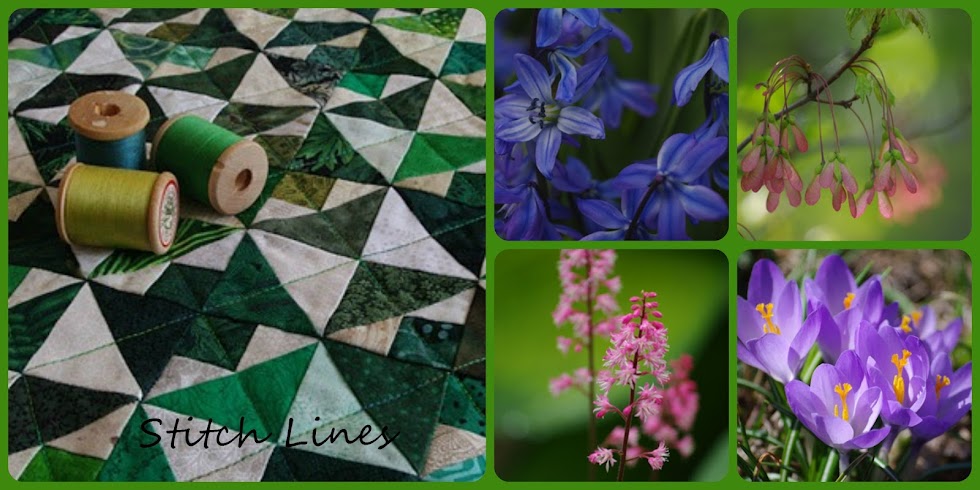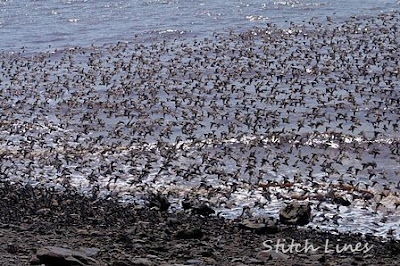 |
| from GraphicMaps.com |

The Bay of Fundy is a 270 km. (170 mile) long ocean bay that stretches between New Brunswick and Nova Scotia. Each day 160 billion tonnes of seawater flows in and out of this bay during one tide cycle. (That's more than the combined flow of all the world's freshwater rivers!) The bay area has many aspects worth exploring: its beaches, sea caves, cliffs and salt marshes, the Tidal Bore, the Fundy Trail, beautiful Fundy National Park, Joggins Fossil Cliffs, whale watching cruises, sea kayaking, and bird watching to name a few.
 |
| Red cliffs along the Shepody Bay area of the upper Bay of Fundy |
Massive flocks of shorebirds, travelling from their nesting grounds in the Canadian Arctic to South America, stop at the Bay of Fundy to feed and fuel up before continuing their migration flight south.
 |
| Sandpipers are small, as you can see here, in comparison to the seagull. There are well over 100 sandpipers in this photo. |
Yesterday I visited Johnson's Mills, just outside Dorchester N.B. to view this spectacle. Thousands of semipalmated sandpipers are currently feeding on the mud flats in the bay area, in fact about 75% of the world's population of semipalmated sandpipers stops here each year. At peak season there can be flocks of up to 200,000!
At low tide they are out on the mud flats feeding on the tiny mud shrimp, corophium volutator, which is found only in the Bay of Fundy and the Gulf of Maine.
As the tide rises, the birds move closer to shore and at high tide, they roost/rest in large groups on the pebble beach, close enough for excellent viewing. Yesterday it was estimated we were looking at 80,000 birds. Of course they are too numerous to actually count accurately; the Interpretors "count" by looking at the shore area covered and estimating 100 birds per square metre. Yes, they are really "packed in."
The semi-palmated sandpiper is not a very big bird, it weighs around 20 grams - the same as a strawberry! But within its two to three week stay here on the bay, it will eat enough to double its weight by consuming 10,000 to 20,000 mud shrimp at each low tide!! These fat stores will provide the necessary energy for the 4300 km. non-stop flight to South America which takes about 72 hours.
Among the semipalmated sandpipers (black legs) one can often see several other species as well- the least sandpiper (distinguished by its yellow-green legs), the black-bellied plover and the semipalmated plover. You can see several plovers in the photo above - they have a black band on their upper breast and are closest to the camera, just above my Stitch Lines watermark.
When resting on the pebble beach, from a distance (and even fairly close up) one would hardly know the birds are there. They blend in so well, they are virtually indistinguishable from the beach rocks. But as one looks carefully, one sees the beach is alive with masses of the tiny birds.
Only when they lift off in flight can you appreciate the vast numbers.
Although we were hoping they would lift off numerous times so we could enjoy the dramatic aerial display as they twist and turn, showing ribbons of alternately light fronts and dark backs, it is best for them to remain at rest to conserve the energy they are storing up for their long migratory flight. Predatory peregrine falcons were nearby and a pair flew by occasionally, causing the sandpipers to lift off and shift their position up the beach.
I was wishing I had the massive lenses that others were using, or video capability, but had to be satisfied with my one telephoto. I hope you will enjoy these still images, but be sure you click the following links to watch several videos of the birds in flight - their aerial dance is so incredibly beautiful; click here and here. They will give you a good idea of what we actually witnessed, as my still photos just don't do it justice. Both were filmed at Dorchester/Johnson's Mills, and the second one is set to music. Almost as good as being there! Nature is so incredibly amazing!
Along with the other birdwatchers present, there was a film crew recording the sandpipers and their incredible aerial dance, for an upcoming CBC series to air in October 2017 on The Nature of Things. The series will be called The Wild Canadian Year - An Epic Journey Through the Seasons. I had a great chat with one of the photographers and cannot wait to see this series. You can follow them through production here at www.cbc.ca/wildcanadianyear.
I took well over 150 photos and am still editing. I'll probably add a few more tomorrow, so I hope you'll come back for another visit.
I am linking with Judith at Mosaic Monday and with Mersad at Through my Lens.
Peace,
Linda
“I think the most important quality in a birdwatcher is a willingness to stand quietly and see what comes. Our everyday lives obscure a truth about existence - that at the heart of everything there lies a stillness and a light.” ~ Lynn Thomson, Birding with Yeats: A Memoir









24 comments:
Neat. And to think my husband thought it was great when he spotted 10 Mourning Doves in our backyard.
I can NOT imagine seeing that many birds at once! We can see a lot when we visit the beach but never anything like this! WOWZA! I'm so glad you got some photos to share. I hope you'll post some more. I'm sending a link to your blog to my hubby! We love to birdwatch! Sweet hugs, Diane
WOW ! I would love to go there one day and take photos . Your photos are awesome and very interesting post I enjoyed it very much ! Thanks for sharing , Have a good day !
Wow, what an incredible experience and I really like The Nature of Things so hope to see the program next year too.
Thanks for linking to Mosaic Monday Linda.
amazing! I am going to click on the video as I leave. I know that many flocks ofnthese birds are sitting on the rocks along the coast of Maine as well...on some islands I think. Would have to check...vague recollection. What an incredible journey to take in 72 hours. It's no wonder they need to bulk up. Fascinating post!
What an amazing sight that would be! That Canadian documentary would be really interesting but it may not be shown here......fingers crossed that it will.
Gorgeous post, Linda!
Fascinating information and amazing photos. I have seen this kind of views only in documentaries; it would be really lovely to be able to visit such places.
Looking forward to more photos! :)
FABULOUS post, Linda - thanks for taking the time to document your experience. They really are something to see.
You are so lucky to have gone there to see this amazing sight!. My grandkids get made all the time saying I always have one eye on my bird feeders and pay more attention to my front yard than I do them. I know I would truly appreciate the experience that you had.
Thanks for sharing your pictures and the links. Marvelous!
xx, Carol
Hello Linda, oh my what a sight to see so many of these shorebirds together. Awesome, I wish I was there too. The shorebirds seem to be on the move now and migrating south. Your photos are wonderful, thanks for sharing. Enjoy your day!
What a sight to witness - WOW!
You live in a place of dramatic weather...dramatic waves! Craggy rocks. I have always wanted to visit there. Loved this post!
Thanks for sharing this spectacle, Linda!! I visited the Bay of Fundy many years ago, perhaps I should plan to come back there in late summer and take in this part of migration!! Amazing numbers!!
A fantastic amount of birds in this post and interesting that there are several Sandpiper species in the flocks.
I was on the other side of the bay at Fundy Park yesterday Linda! :) We were talking about the sandpipers at Johnson's Mills and kind of wishing we could see them. I'm so glad you got down and took these great photos of them. They truly are an amazing sight to see. I have a photo of them from Cape Enrage flying over the bay taken several years ago. Are you keeping cool?
Just amazing and your photos are wonderful. I love the quote--how true. You live in a beautiful area!
Hey! I was there last week for just this purpose - so neat to finally take this in. The interpreters were certainly helpful - it was just beach and rocks to me until they pointed out what we were looking at. I didn't take any pictures, so it's nice to see yours.
My goodness! The cluster of sandpipers is amazing!
Thank you for posting this. Won't you please link up at http://image-in-ing.blogspot.com/2015/08/double-play-on-way.html?
Fantastic images Linda and thank you for the video links. I can't imagine the stamina it takes for those birds to stay in flight for 72 hours. They need every one of those shrimps they consume. Thank you for such a very interesting post.
That's a lot of birds! I love how they can all fly off at the same time.
I am absolutely stunned by the number of birds - it is my fondest dream to come upon a large flock of shorebirds one day. They are sparse in our local area (Pacific Northwest) because our shores are rocky and don't have the food they require. When I see some they are either solitary or in groups of 3-5 - and they bring me such joy - I'm always on the lookout for them. Your photos are amazing - I enlarged them and looked and looked - what fabulous shots - I do hope you post more.
Oh this was amazing...I loved learning about The Bay of Fundy...what a fascinating spot and so incredibly beautiful...and all those sandpipers....my goodness what a sight!
Great pictures and loved the story! Thoroughly enjoy your blog and look forward to it!
Oh How Magnificent and I just cannot begin to imagine the sounds, the noise when they rise to the air. Loved this visit so much~
Post a Comment